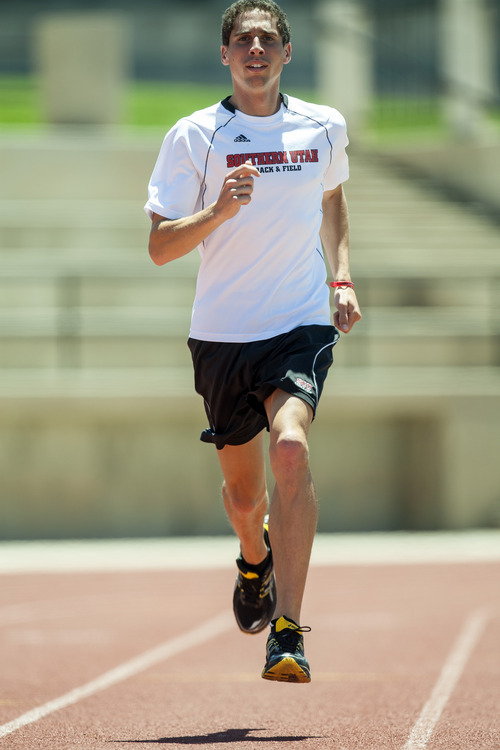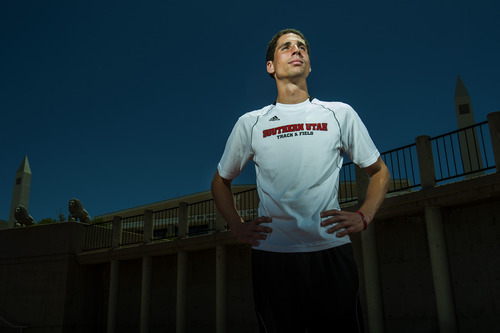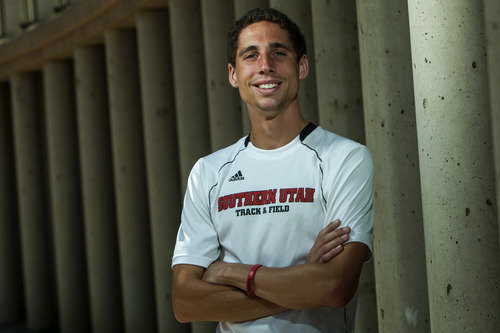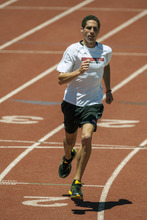This is an archived article that was published on sltrib.com in 2012, and information in the article may be outdated. It is provided only for personal research purposes and may not be reprinted.
Cedar City • When distance runner Cam Levins began his senior year at Southern Utah University last fall, he knew he was ready for a big finish to his collegiate career. He was fit enough to run as fast as ever. He was dialed into his training as never before. He even figured he had a pretty good shot at reaching the Olympics.
But even he acknowledges, "I didn't see this."
Of course, nobody did.
Nobody could have.
Five years after emerging from a tiny rural high school in Canada so unknown and modest in his talents that he had to lobby for college scholarship offers, the 23-year-old Levins has unexpectedly become one of the most stunning stories in international track and field — with a place at the 2012 London Olympics already all but assured.
Within a span of nine days to start his season earlier this spring, Levins unleashed two of the most prodigious races in college history, stunning the track community by clocking 13:18.47 in the 5,000 meters at the Mt. SAC Relays and 27:27.96 in the 10,000 at the Cardinal Invitational at Stanford.
Both times were much faster than his previous bests, and fast enough to qualify for the Olympics. Then, earlier this week, he won both the 5,000 and 10,000 at the NCAA Track & Field Championships in Iowa to become SUU's first national champion and just the 11th man to win the "distance double" — along with such running luminaries as Ed Eyestone, Meb Keflezighi, Gerry Lindgren and Galen Rupp.
"I don't know if I would have thought I would be this good, or run as well as I have," he said recently, squinting in the bright sunshine at the SUU track. "I really felt like I had a good shot at the Olympics, even before the whole season started. But it certainly went over any expectations I could have had."
The thoughtful and easy-going Levins won both his early-season races with huge kicks off an obviously fast pace — he edged three-time national champion Lawi Lalang in the 5,000 — and his time in his first-ever 10,000 on the track (an "experiment," he says) stood as the fastest in the world for several weeks.
And yet, all of that might have been only the second-most amazing thing about him.
The first?
Levins and his coach say Levins regularly runs 150 miles a week to accomplish his results — an almost inhuman amount of training that flies in the face of modern training philosophies and recalls the dawn of the running boom, when the first generation of serious runners thought success was built on relentless pounding, mile after merciless mile.
Nowadays, even elite marathoners seldom run quite that much in training.
"We've tried some things that I know people would shake their heads at and say, 'You're lying,' " coach Eric Houle says. "Well, I don't care. All I know is that it's working for us."
That much is clearly true, whatever they're doing.
And that part is anybody's guess.
—
Top-secret workouts • Both Houle and, by emphatic coaching mandate, Levins refuse to talk specifically about their workouts. Houle says he protects those details the way football coaches protect their playbooks, which only adds to the sense of mystery and intrigue surrounding Levins.
All either one will acknowledge is the mileage total, and the fact that Levins usually runs three times a day to achieve it — all because Levins decided a couple of years ago that increasing his mileage was the only way he was going to reach an elite level.
"I feel like I maybe have taken an old-school approach to the training," he acknowledges, "but it has really worked for me."
Even more unconventional?
Houle says Levins doesn't "taper" in the conventional sense, or significantly reduce his mileage in the days before an important race, in an effort to be fresher.
"We find that we run our best when we're working our hardest," Houle says. "When we start to taper, that's when we start to have problems. All I can say is that is a little bit of a theory that we operate on. So will he taper, before the Olympics? Well, if you're running 30 miles a day, and you cut 3 miles off, that might be enough taper. But to get him down below 10 miles? That's not going to happen. Absolutely not."
Boy, that's not just outside the box. That's outside the box, down the road, right at the stop sign and on the bus to Parowan.
—
Happy to be different • Still, Levins is fine going his own way.
He was the only distance runner in a bare-bones track program in little Black Creek, a town of a few thousand on Vancouver Island in British Columbia, but became a high school island champion in both track and cross-country.
That wasn't enough to attract a flood of scholarship offers, but Levins posted his athletic résumé on a recruiting website for coaches to peruse, then sent a letter to SUU when Houle expressed interest. Ultimately, the Thunderbirds were the only Division I program in the country to offer enough of a scholarship for Levins to afford taking it.
"I'm not exactly from a rich family," he said.
From there, it has been a steady climb.
Always a hard worker and frequent racer, Levins became the first runner in SUU history to run a mile in under 4 minutes, two years ago. He also became known for running several events at most track meets, including an astonishing four at both the Summit League indoor and outdoor championships. He won the 800, mile, 3,000 and 5,000 indoors in February, and the 1,500, 5,000 and 10,000 outdoors last month, with a third-place finish in the 800.
No wonder the guy barely blinks at 150 miles a week.
"I really feel like many athletes are capable of doing it," he says. "It's just a matter of not rushing into it. I didn't just suddenly jump up to this. It has been years of slowly putting on a few more miles a day, each year. I wasn't rushing through it. I wasn't thinking 'OK, I'm going to end up at 150 miles by my senior year.' It was just like, 'OK, if I want to keep improving, I feel like I should tack a bit more mileage on.' I was just looking to change little things in my training."
—
Chasing medals • Now, he's all but running in London.
Levins was busy competing at the NCAA Championships this weekend, and still must race the Canadian Olympic trials at the end of the month. But that's almost a sure thing, since he's by far the most talented runner in his events and needs to finish only in the top three of his races to officially book his ticket.
After that, he hopes to run one of the Diamond League pro meets in Europe before the London Games, then probably come back to Cedar City before leaving again for Team Canada's pre-Olympic training camp in Germany on July 22.
He's planning on running both the 5,000 and the 10,000 in the Olympics.
"It's weird to think that I'll plan on doubling my first time going," Levins says. "I never really thought I would do that. But I sort of feel, when I look at it, that if I didn't do the 10 and just went and did the 5, I'd watch the 10 go by and go, 'Ugh, I'm sure I could have recovered in time. I'm sure I could have done it.' "
And medals?
Are those in the dreams? Fans on the popular LetsRun.com message boards have been debating his podium prospects with vigor.
"Coming into this year, I felt like if I made it to the Olympics, I just wanted to try to make the finals in the 5K," Levins says. "And I'm not going to look too much beyond that. I just want to make it there and try and hang in the race and see what I can do if I'm still there with a lap left. I don't expect to medal. I don't expect really anything. I'm just going out there and experiencing it. It's just cool to be able to go."
Twitter: @MCLTribune —
Cam Levins file
• Owns the only track national championship and sub-4-minute mile in Southern Utah history
• Almost certainly will compete for Canada at the 2012 London Olympics
• Majoring in exercise science
• Father Gus Levins owns a small lawn-care business, and mother Barb Levins works for the Vancouver Health Authority —
Distance doubles
Southern Utah's Cam Levins is among just 11 men who have won the 5,000 and 10,000 meters at the same NCAA Outdoor Track & Field Championships:
Year Athlete School
1963 Julio Marin USC
1965 Doug Brown Montana
1966-68 Gerry Lindgren Washington State
1975 John Ngeno Washington State
1980-82 Suleiman Nyambui UTEP
1983 Gadamis Shahanga UTEP
1985 Ed Eyestone Brigham Young
1997 Meb Keflezighi UCLA
2000 Brad Hauser Stanford
2009 Galen Rupp Oregon
2012 Cameron Levins Southern Utah
Source: NCAA









